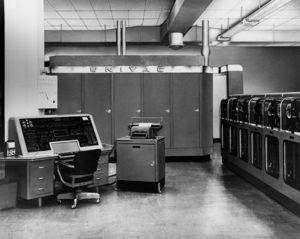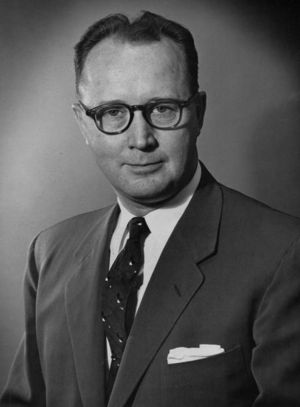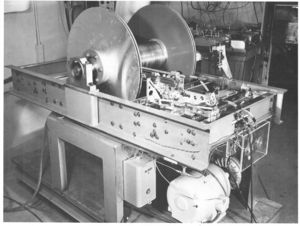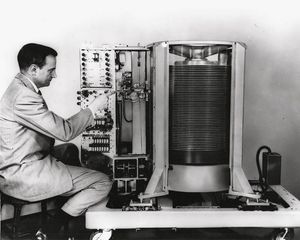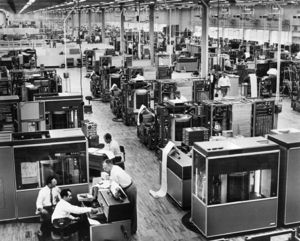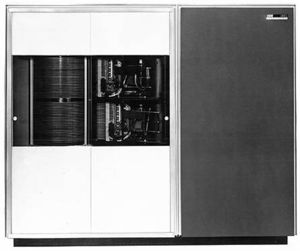Creating Magnetic Disk Storage at IBM
This article was initially written as part of the IEEE STARS program.
Citation
Seeking outstanding engineers, IBM established a laboratory in San Jose, California, in 1952. The laboratory chose to develop a magnetic disk storage product as its primary mission. In 1956 deliveries began of RAMAC, the world’s first computer with magnetic disk storage. Improvements made by IBM engineers in the cost/performance of disk storage technology began following an exponential rate that continued for more than half a century. Over 50 other companies entered the business. The resulting ability to store and access vast amounts of data at very little cost has altered our lives and transformed the Information Age.
Introduction
Events leading to the creation of the first magnetic disk storage product began in the early post-World War II years. IBM’s president, Thomas J. Watson, Sr., gave high priority to upgrading all products, using electronics where possible, and finding jobs for all employees who were returning from the armed services or who had been producing war materiel. An early action was to convert the IBM plant in Poughkeepsie, New York, from manufacturing war materiel to manufacturing the company’s upgraded electric typewriters.
A personal priority was to get his two sons into leadership positions in IBM. When Mr. Watson’s older son, Thomas J. Watson, Jr., returned from the Army Air Force and rejoined IBM in January 1946, his father arranged for him to meet with J. Presper Eckert and John W. Mauchly at the Moore School of the University of Pennsylvania. There he saw the room-sized electronic calculating machine they had built. Known as ENIAC, the Electronic Numerical Integrator and Computer contained 18,000 vacuum tubes. Burned-out and other nonfunctioning tubes were replaced almost daily. Watson, Jr., was certain that this machine had no commercial value.
Entering Electronics
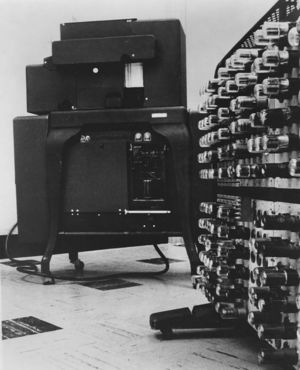
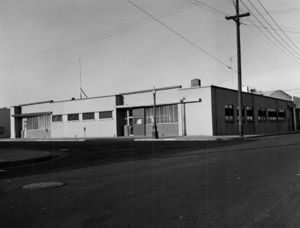
A few weeks later, Watson’s father showed him the company’s top-secret electronics project. It was a fully operational product prototype with electronic arithmetic circuits. The young Watson was impressed. He urged his father to announce this machine and to market it as “the world’s first commercial electronic calculator” – even if only a few could be sold. Tom Watson also accepted his father’s offer that he be responsible for the company’s entry into electronics.
The product prototype was announced later that year as the IBM 603 Electronic Multiplier. It contained approximately 300 vacuum tubes. (See Fig. 1) Two years later, it was replaced by the faster and more versatile IBM 604 Electronic Calculating Punch with over 1,400 vacuum tubes of a new and smaller type. Beginning in 1949, the IBM 604 was also offered in combination with other equipment to create the Card Programmed Electronic Calculator (CPC), which was unofficially known as the “poor man’s ENIAC.”
IBM’s market leadership in electronic computation and data processing was jolted in 1951 when the U.S. Census Bureau accepted the first UNIVAC. (See Fig. 2) It was designed by Presper Eckert and John Mauchly, who had previously designed the ENIAC. Its arithmetic and logic functions were implemented with electronic vacuum-tube circuits. The high-speed main memory was implemented with an acoustic mercury delay-line. Very significantly for IBM, UNIVAC’s engineers used metallic magnetic tape, instead of punched cards, to store information.
The possibility that IBM’s punched-card equipment could be replaced by electronic computers equipped with magnetic-tape storage devices was a sobering thought. The concern of Watson, Jr., was heightened by the fact that IBM’s primary competitor in punched-card equipment, Remington Rand, had purchased the Eckert-Mauchly Computer Corporation in 1950 and Engineering Research Associates (ERA) in 1952.
These two startup companies were technologically strong. The Eckert-Mauchly Computer Corporation had developed UNIVAC. ERA was established in January 1946 to work on secret military projects. Among other achievements, ERA had become the leader in developing rotating magnetic drum memories. One of these served as the main memory on ERA’s first computer, the Atlas 1, which was delivered to the United States government in December 1950. ERA announced the commercial version, the ERA 1101, one year later.
Fearful that he would fail in the job his father gave him, the young Watson demanded ever greater efforts from his engineers. He also convinced his father to authorize a four-fold increase in the number of employees in research and development (R&D) from fewer than 1,000 in 1950 to more than 4,000 five years later.
Still the company’s R&D capabilities were strained to the limit. Also, a serious recruiting problem was revealed. There was a shortage of qualified engineers, especially in electronics; and many engineers, especially those on the West Coast, were reluctant to relocate to Poughkeepsie or Endicott, New York.
Establishing the IBM San Jose Laboratory
To facilitate the hiring of engineers from the West Coast, IBM developed a plan to establish a laboratory in San Jose, California, under the leadership of Reynold B. Johnson. (See Fig. 3) Johnson had been hired by Watson, Sr., in 1934 to develop the first automatic test scoring machine, based on work Johnson had done as a high school science teacher and inventor from Ironwood, Michigan. This machine introduced the concept of electrically sensing pencil marks made on paper. It was announced in 1937 as the IBM International Test Scoring machine.
Named manager of the IBM San Jose Laboratory in January 1952, Johnson signed a five-year lease for a small building. (See Fig. 4) Advertisements for scientists and engineers yielded so many top-quality responses that Johnson concluded he needed someone with a strong electronics background to help in assessing applicants. To fill this role, he chose Louis D. Stevens, who had three years experience as a radar technician in the US Marine Corps, worked three years as an engineer in the IBM Poughkeepsie Laboratory, and had a Masters Degree in Electrical Engineering from the University of California at Berkeley. Stevens accepted the position of Johnson’s technical assistant and began reviewing job applications. The number of employees in the new San Jose Laboratory was increased to 30 by early summer and to 60 by the end of the year.
Having worked directly for Watson, Sr., for many years, Johnson was familiar with his methods. The older Watson personally hired and managed the company’s senior technical people, who were called inventors. He told the inventors what product improvements were needed and then assigned one or more of them to each task. Because more than one inventor might be assigned the same task, inventors seldom discussed their work with each other.
Johnson also knew that Ralph L. Palmer had established a more open environment in the IBM Poughkeepsie Laboratory in 1950, when he was given responsibility for all developments in solid-state devices. Palmer believed the only way IBM engineers could get ahead of the fast moving external competition was to share information and ideas with each other.
In the San Jose Laboratory, Johnson took this concept one step further. He told the engineers that they should be familiar with every project in the Laboratory. Then he said the number one priority of each engineer was to help other engineers in the laboratory. The second priority was to work on one’s own assignment. This policy has been given credit for creating a cooperative environment that stimulated rapid technical progress.
Automating the Punched-Card Tub File
A primary task for several months was to identify good research projects for new employees. Arthur J. Critchlow arrived at IBM in April 1952 with some industrial experience and a bachelor degree in Physics from Caltech. His initial assignment was to study the manner in which information was organized, formatted, stored, and processed using punched-card equipment – and then find a better way. He learned that punched-card equipment performed customer tasks best when processing could be done in batches on sequentially sorted information. Serious problems arose when more nearly random access was needed.
Inventory control was a particularly important application of the more nearly random type. Typically, each order required that several cards be located manually, removed from the stack of cards, and replaced by updated cards. To facilitate this clerical activity, drawers of cards were set out on work tables so that several persons could access cards from the same file. This arrangement was called a “tub file.” Replacing this inelegant, tedious, and error-prone process soon became the project’s objective.
One of Critchlow’s first proposals was for a conveyor belt that would bring punched cards to the clerks instead of having clerks walk around looking for punched cards. However, what was really needed was a superior random access data storage device. Numerous types were considered. Magnetic tape was unacceptable because of the long time required to reel the tape from one location to another. Rotating magnetic drums provided rapid access to stored information, but because information was stored only on the outside surface of a rotating cylinder, volumetric efficiency was low and costs would be high. Magnetic core arrays could provide even more rapid random access to data, but they were too expensive for this application. Among all the structures considered, theoretical analyses predicted that magnetic disks would be superior.
Despite the theoretical advantages of magnetic disk storage, IBM engineers knew of no product development efforts in the nascent computer industry. Indeed, the only experimental work on magnetic disk storage known to IBM engineers was published in a technical journal in August 1952 by Jacob Rabinow, an inventor at the National Bureau of Standards. In Rabinow’s design, several disks with one large notch cut out of the edge of each disk were mounted on a shaft that had been bent into the shape of a ring. The notches were normally aligned toward the center of the ring so that a read-write head could be rotated through the notches of the disks to any desired disk. Information was then written on, or read from, the selected disk by rotating the selected disk one full turn. Disks not selected for the read-write operation remained stationary.
On January 14, 1953, after studying Rabinow’s notched-disk memory design, IBM engineer Geoffrey A. Hotham documented in his engineering notebook a modification that envisioned a continuously rotating straight shaft containing several magnetic disks, without notches, and each disk containing several coaxial recorded tracks. He showed this to Critchlow, who in a report dated February 2, 1953, proposed replacing the punched-card tub file with an array of continuously rotating magnetic disks with independent access stations.
Courageous Decisions
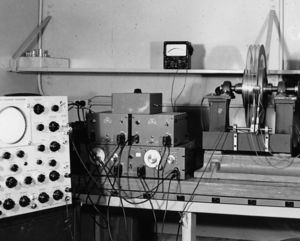
In the interactive and cooperative environment Johnson had established, word of Hotham’s magnetic disk storage proposal spread rapidly. Potential problems and solutions were identified and discussed. Ultimately, the successful disk storage design consisted of a number of disks spinning continuously on a straight shaft. A pair of read-write heads was moved parallel to the shaft until it reached the desired position. Then the two heads were thrust into the disk stack at opposite sides of the selected disk to reach the desired track. Designing a device to put the read-write heads into position rapidly and precisely would not be easy. However, maintaining the fixed, tiny space required between each recording head and the surface of a disk appeared to be even more difficult. Unlike magnetic drums, magnetic disks had a very large diameter to thickness ratio that would cause them to wobble at high rotational speeds.
Despite these problems, the potential advantages were so great that before the end of January 1953, Johnson selected magnetic disk storage over all other data storage options. He directed that no effort be spent on other options. (See Figure 5) This was not a universally popular decision because the anticipated engineering problems were huge. John M. Harker, who had been hired eight months earlier with a masters degree in mechanical engineering from the University of California, told Johnson that he was “backing a mechanical folly.” Perhaps the magnitude of the engineering problems helps to explain why no other company had undertaken this development.
At about this time, the U.S. Air Force sent a request for bid to thirty companies for an inventory control system. Transactions had to be processed as they arrived. To do this, the system required a very large capacity random access memory. Systems engineers in the San Jose Laboratory accepted responsibility for responding on behalf of IBM. The proposal submitted on April 1, 1953, called for the use of many conventional rotating magnetic drum memories because Johnson was not prepared to commit a magnetic disk storage device in a bid to the U.S. Air Force. IBM failed to win the contract. In retrospect this was fortunate because it allowed Johnson to assign more engineers to the project that achieved far more valuable results.
In early April 1953, Johnson attended an IBM sales convention in Los Angeles. There he met with key sales representatives and corporate executives who convinced him of the urgent need for new products. Upon returning to San Jose, Johnson announced that the planning phase was over. The Laboratory was committed to developing a new system, capable of processing arbitrary transactions against a firm's operative data as recorded on magnetic disks, instead of on punched cards or magnetic tapes. Engineers who worked with Johnson recall this as a courageous decision.
Designing the RAMAC Computer
John W. Haanstra was responsible for the new computer system design; he had been hired after graduating from the University of California, at Berkeley. His criteria for the system were that it be inexpensive and easy to program. The target rental price was $2,000 per month ($17,000 if inflation-adjusted to 2012). For programmability, it needed to be easily understood by users of ubiquitous punched-card equipment.
Haanstra's 1953 design for the "Direct Record Access Memory" (DRAM) system, later renamed RAMAC, was a compromise between the new paradigm of stored-program computing and traditional plugboard control panels. Haanstra believed that the pure stored-program model would be too unwieldy for punched-card equipment users. Therefore, his hybrid design called for logical decisions to be programmed on a traditional plugboard control panel. Stored-program style instructions were used to transfer variable-length character strings between disk locations. Instructions were executed from a small magnetic drum, holding up to 200 instructions on 20 tracks. Additional drum tracks held machine registers, specified arithmetic operations, and handled input-output transfers. The system also had a small magnetic-core memory for buffering data transfers, and it used the IBM 604 vacuum-tube and relay-circuit technologies.
Developing Disk Storage for RAMAC
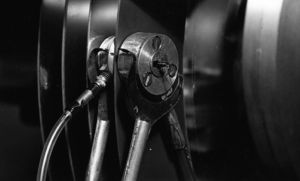
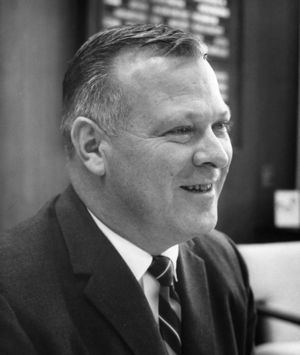
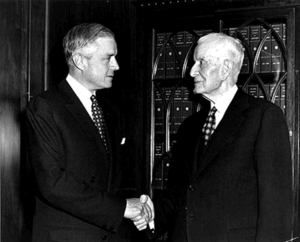
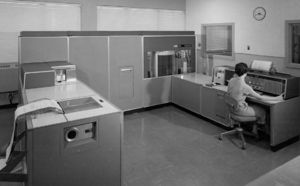
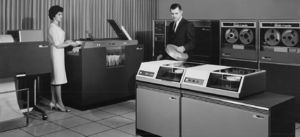
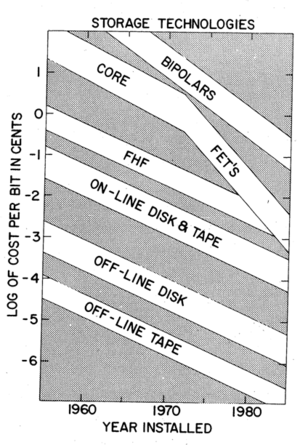
After fully committing the San Jose Laboratory to developing a magnetic disk storage product, Johnson put William A. Goddard in charge of developing the first disk storage model. Among the engineers he assigned to Goddard was G. A. Hotham, who had sketched the first design of the desired structure in his engineering notebook only three months earlier.
The disk storage design, as finally implemented, had a vertical shaft on which were mounted 50 continuously rotating aluminum disks. Each disk was 24 inches in diameter, one tenth of an inch thick, and was coated with a magnetic paint. A spacing of three tenths of an inch between disks was sufficient to allow magnetic read-write heads to be positioned to any one of the 100 tracks on both sides of each disk. Each track could hold 500 alphanumeric characters, so the storage capacity of the entire unit was 5 million characters. Disks rotated at 1,200 revolutions per minute, and the maximum time required to position a read-write head on the desired track and sector of the desired disk was about 0.8 second.
Engineers identified and overcame many problems before this design was achieved. The first aluminum disks wobbled too much. Making them slightly thicker reduced the problem sufficiently for the first RAMACs. Later models used laminated aluminum disks that were produced by heating layers of aluminum above the annealing temperature under high pressure. The first successful magnetic coating was paint containing a dispersion of iron-oxide particles, which had been formulated by Jake Hagopian. Coating disk surfaces by spraying on thin layers of paint made the surfaces too rough. Soon after Hagopian was assigned full-time to the project in the fall of 1953, he devised a method for achieving smoother coatings by pouring the coating at the center of a rapidly spinning disk and allowing centrifugal force to spread the coating uniformly.
The engineering problem expected to be most difficult was maintaining the desired spacing between the read-write head and a rotating disk, so that damage to the disk was avoided while data was reliably read from and written on the disk. Even before Goddard was put in charge of developing the magnetic disk storage model, he believed that using an air bearing “was just the only way to do it,” but he had difficulty convincing others. Now that he was in charge, he gave a sketch to a person in his group. Within two weeks, the air head had been built and tested with surprisingly good results. By early June 1953, a third version of an experimental air bearing was assembled with a read-write head that had been manufactured for a magnetic-drum product. (See Figure 6) Using this read-write head structure, data was written into the magnetic-oxide-coated aluminum disk at 51 bits per inch and read back for several hours before an error occurred.
Johnson was pleased by the progress being made in building the first magnetic disk storage model and in designing the overall data processing system. Now he needed to identify an engineer capable of leading the entire project through product development. In November 1953, he promoted Stevens to senior engineer and manager of the RAMAC project. (See Fig. 7)
Only three months later, there was more good news. On February 10, 1954, the first random-access file test bed was used successfully to transfer data to and from a rotating magnetic disk. (See. Fig. 8) Progress seemed less rapid in designing mechanisms for moving the read-write heads to the selected disk; thrusting the two heads into the narrow spaces on either side of the disk; and finally reaching the desired track.
Three engineering teams were pursuing three different approaches. Initially, a servo system was favored for the track-to-track drive, but a different approach was favored for moving the heavy carriage from disk to disk. Ultimately, John Lynott devised a way to use a single electrical servo system in a multiplexing mode to handle both of these jobs. This was a significant simplification that reduced hardware costs and improved reliability. (See Fig. 9)
Product Announcement, Delivery and Competition
In January 1955, Stevens advised Johnson that the first of five engineering prototypes was fully operable. IBM’s top management recognized the significance of the RAMAC project and authorized Johnson to build 14 prototype systems for use inside IBM and by selected customers. The purpose was to obtain early information on customer usage and product reliability. The first delivery of an engineering prototype to a customer was made in June 1956.
In September 1956, Watson, Jr., formally announced the IBM 305 RAMAC system. It had been a momentous year. In addition to announcing RAMAC, he had settled the antitrust suit begun in 1952 by the U.S. Justice Department; the first computer in the massive SAGE air-defense system was installed; he had replaced his father as IBM’s chief executive officer in May; and in June the older Watson died of a heart attack. (See Fig. 10)
The RAMAC system that Watson, Jr. announced consisted of a 305 processing unit, a 350 disk storage unit, a card reader-punch, a printer, a console, and a power supply. The monthly rental was $3,200, of which $650 was for the disk storage unit. (If adjusted for inflation to 2012, these prices are $26,000 and $5,200.) (See Fig. 11)
Simultaneously with the RAMAC announcement, the 350 disk storage unit was offered as a peripheral attachment to the popular IBM 650 computer, which had a rotating magnetic drum main memory. This combination was called the IBM 650 RAMAC. The name “RAMAC” came to mean Random Access Method of Accounting and Control, which conveyed the idea that all related accounting ledgers could be updated every time a transaction card was read. Delivery of production models of the IBM 305 RAMAC began in June 1957. One year later, the system was enhanced to permit attachment of two storage units rather than just one. IBM built over one thousand IBM 305s before production ended in 1961. (See Fig. 12)
The most significant competition to RAMAC was provided by Remington Rand, whose Univac File Computer was equipped with up to ten magnetic drums. The Univac File Computer offered substantially better performance than RAMAC, but at a higher price. The first production model was delivered in August 1956, ten months before production models of RAMAC. This competitive offering put great pressure on IBM engineers in San Jose. However, even when equipped with its maximum of ten drums, the Univac File Computer offered only 1.8 million characters, which was about one-third the storage capacity of RAMAC. The cost-performance superiority of disks over drums became increasingly evident during the ensuing years.
Post-RAMAC Activities
After putting Stevens in charge of the entire RAMAC Project back in 1953, Reynold Johnson had devoted more of his time to what he liked best: working on new ideas. Most important was the work on aerodynamic sliders, which flew read-write heads at a fixed distance from a rotating disk without using forced air. The study of slider technology was begun in early 1955 and was supported by similar studies already under way in the IBM Watson Laboratory in New York City and in the IBM Airborne Computer Laboratory in Vestal, New York. Information on related phenomena was available in the technical literature of mechanical engineering under the term “plane-slider bearings.”
Late in 1957, this activity was placed under Stevens, with Alan F. Shugart as engineering manager. Shugart joined IBM as a field engineer in 1951 and subsequently gained experience in several RAMAC assembly and product engineering assignments. His task now was to expedite development of an aerodynamic-slider-based Advanced Disk File (ADF) for use on large computers. To achieve an early product delivery schedule, many promising but unproven concepts were dropped. These included voice-coil actuators, which were successfully introduced in the mid-1960s with track-following servo systems; and perpendicular (rather than longitudinal) magnetic recording, which did not fulfill its promise of higher recording density in products until 40 years later.
While Shugart was leading this product-development effort for IBM, others in the computer industry engaged in related efforts. The publication in 1952 of the article titled, “Engineering Design of a Magnetic-Disk Random-Access Memory” by Noyes and Dickinson of IBM was widely read in the technical community. Numerous companies began their own development efforts. One of these, Bryant Computer Products, shipped the first slider-technology disk storage unit to the U.S. military in November 1960 and was rumored to be developing technology suitable for the commercial market. This put a lot of pressure on Shugart and his colleagues.
In June 1961, IBM announced its first disk-storage product with slider technology as the IBM 1301 Disk Storage. It was designed for use on the IBM 1400 family and 7000 series of computers and also on the American Airlines SABRE reservation system. The 1301 could be ordered with one 25-disk module or with two modules, one mounted above the other on the rotating vertical shaft. Each module was served by a comb-like access mechanism that moved 24 arms in concert. Each arm had two recording heads, one to serve the surface above the arm and one the surface below. Once the comb had been positioned, the active head was selected by electronic switching. (See Fig. 13)
With one head for each disk surface, the performance of the unit was substantially better than RAMAC and similar to that of the Univac File Computer – but at a much lower cost. It was the first clear evidence in the market that magnetic drums would not long survive the onslaught of magnetic disk storage devices.
Of considerable significance historically is that the IBM 1301 achieved a bit-storage density of 26,000 bits per square inch. This was 13 times greater density than on RAMAC. Two years later, a follow-on product, the IBM 1302 Disk Storage, provided an additional four-fold increase in storage density.
Also of significance is the 1962 announcement of the IBM 1311 Disk Storage Drive, which featured the first removable disk packs. (See Fig. 14) Its first hosts were IBM’s smaller computer systems: the 1401, 1440, 1620 and 1710. Each removable pack contained six 14-inch diameter disks, weighed less than 10 pounds, and had a storage capacity of 2 million characters, which equaled that of 25,000 IBM punched cards. Work toward this product had been initiated in 1958 by John M. Harker, who had previously led research work on aerodynamic sliders. The convenience and good performance of removable disk packs accelerated the transition from punched-card systems to computer systems.
Expanding the Industry
Reynold Johnson, Louis Stevens, and John Haanstra saw themselves as creating an innovative total system, not just a disk storage component. History reveals, however, that the disk storage component led to many generations of products, whereas the RAMAC computer system had no progeny because of the ultimate superiority of stored-program computers.
Disk storage as a peripheral device for stored-program computers gained popularity as the cost and performance of disk storage, main memory, and computer logic improved. However, not until the IBM System/360 line of computers was introduced in 1964 were IBM operating systems able to take full advantage of the technology. This capability plus the all-important standard interface for peripheral devices, pioneered by System/360, created a vast new market for disk storage products for IBM and its competitors.
Among those to benefit was Alan F. Shugart, who had served as engineering manager of IBM’s Advanced Disk File (ADF) project. In 1969 he left IBM to join Memorex, which had already become the first independent company to manufacture and ship magnetic disk packs (1966) and IBM-plug-compatible disk drives (1968). When Memorex came to hard times in 1972, Shugart talked several others into joining him in launching Shugart Associates. There he pioneered the use of floppy disks in personal computers. Floppy disks had been invented at IBM in one of the engineering groups managed by Shugart.
Following a dispute over company direction with his board of directors in 1974, Shugart left the company he had founded – which still retained his name. For more than two years, he bided his time. Then in 1978 Shugart joined several others in forming Seagate Technology to develop and manufacture hard-disk drives for personal computers. The market for disk drives grew rapidly, and Seagate expanded its product offerings. (See Fig. 15)
By 1982, over 50 vendors offered competitive disk storage products in a $15 billion marketplace. Among the largest of these were Ampex, CDC, Fujitsu, Hitachi, IBM, Memorex, Mitsubishi, NEC, Olivetti, Quantum, Seagate, Shugart, Tandon, and Toshiba. The IBM 3380 disk drive, announced in 1980 and used with its mainframe computers, brought in annual revenues of more than $7 billion, which was about half the total disk storage market. But by 1995, Seagate Technology, with Shugart its CEO, had become the dominant company in disk drives for workstations and mainframes. Its annual revenues of $8 billion a year accounted for one-third of the total disk-drive market.
Advances in Storage Technologies
Just six years after RAMAC was announced, the IBM San Jose development team had created significantly improved disk storage products that began an exponential rate of improvement that characterized disk storage for more than half a century. Disk storage devices today have dramatically better access times, data rates, and storage densities than RAMAC. A similar exponential rate of improvement in semiconductor technology is widely known as Moore’s Law. In both cases the underlying cause is a series of innovations that increase the density of devices or storage on a planar surface with a relatively small change in processing cost per area.
A typical computer is equipped with a hierarchy of different types of data storage technologies, carefully selected and coupled together to provide the most effective overall cost and performance. Each of these technologies exhibited an exponential rate of decrease in cost per bit. (See Fig. 16) Rapid improvements in the cost/performance of these technologies led to new applications that have significantly altered the way people do business, obtain information, and interact with each other.
Timeline
- 1945, ENIAC begins first test runs at the University of Pennsylvania
- 1946, IBM 603 Electronic Multiplier is announced
- 1948, Deliveries begin of the IBM 604 Electronic Calculating Punch
- 1950, ERA delivers computer with magnetic drum memory to National Security Agency
- 1951, First UNIVAC is accepted by the U. S. Census Bureau
- 1952, IBM establishes laboratory in San Jose, California
- 1952, National Bureau of Standards researcher describes notched-disk magnetic memory
- 1953, Magnetic disk storage development becomes focus of IBM San Jose Laboratory in April
- 1955, First engineering prototype disk storage unit is operational in January
- 1956, First customer delivery of disk storage as part of a RAMAC engineering prototype
- 1957, Deliveries begin of IBM 305 RAMAC with production models of IBM 350 disk storage
- 1961, IBM announces 1301 Disk Storage product with aerodynamic slider technology
- 1962, IBM announces 1311 Disk Storage Drive with removable disk packs
- 1964, IBM System/360 is announced with a standard interface for peripheral equipment
- 1968, Memorex manufactures the first IBM-plug-compatible disk drives
- 1978, Seagate Technology is founded by Alan F. Shugart and others
- 1982, Over 50 vendors offer disk storage products in a 15 billion-dollar marketplace
Bibliography
References of Historical Significance
T. Noyes and W.E. Dickinson. 1952. “Engineering Design of a Magnetic-Disk Random-Access Memory”. Proceedings of the Western Joint Computer Conference, February 1952, p. 42-4
J. Rabinow. 1952. “The Notched-Disk Memory”. Electrical Engineering, August 1952, p. 745-9
M. L. Lesser and J. W. Haanstra. 1957. “The Random-Access Memory Accounting Machine, part 1: System Organization of the IBM 305”. IBM Journal of R & D, January 1957, p. 62-71
T. Noyes and W. E. Dickinson. 1957. “The Random-Access Memory Accounting Machine, part II: The Magnetic-Disk, Random-Access Memory”. IBM Journal of R & D, January 1957, p. 72-75
L. D. Stevens, W. A. Goddard, and J. J. Lynott. 1964. U.S. Patent 3,134,097, “Data Storage Machine”. Filed December 24, 1954 and patented May 19, 1964
W. A. Goddard and J. J. Lynott. 1970. U.S. Patent 3,503,060, “Direct Access Magnetic Disk Storage”. Filed December 24, 1954 and Patented March 24, 1970
E. W. Pugh. 1972. “Alternatives to Magnetic Recording”. in C. D. Graham, Jr., and J. J. Rhyne, eds. Magnetism and Magnetic Materials 1971, AIP Conference Proceedings No. 5 (New York: American Institute of Physics, 1972) p. 31-44
References for Further Reading
David W. Kean. 1977. IBM San Jose: A Quarter Century of Innovation. San Jose, CA: International Business Machines Corporation, 1977
C. J. Bashe, L. R. Johnson, J. H. Palmer, and E. W. Pugh. 1986. IBM’s Early Computers, Chapter 8. Cambridge, MA: The MIT Press, 1986
Louis D. Stevens. 1998. “Data Storage on Hard Magnetic Disks” (Chapter 18). E. Daniel, C. Mee, and M. Clark, Magnetic Recording: The First 100 Years (Piscataway, NJ: IEEE Press, 1998), p. 270- 99
Albert S. Hoagland. 2005. Early History & a 50 Year Perspective on Magnetic Disk Storage. Magnetic Disk Heritage Center, 28 February 2005, www.magneticdiskheritagecenter.org/MDHC/Magnetic%20Disk%20Storage.pdf
About the Author
Emerson W. Pugh is the author or coauthor of a college physics text book and four books on the history of IBM and the computer industry. He has a PhD in physics from Carnegie Mellon University and worked for IBM for 36 years in many capacities, including research scientist, product development manager, and corporate executive. He served as president of the IEEE in 1989, chair of the IEEE History Committee in 1996 through 1998, and president of the IEEE Foundation in 2000 through 2004.
Acknowledgements
Contributions by David Bennet and Robert Garner were exceptional. The author is also grateful to Joseph Feng, Albert S. Hoagland, John H. Palmer, Edward Thelen, and the STARS Managing Editor, Alexander Magoun, and members of the Editorial Board for reviewing the manuscript and making many helpful suggestions.
